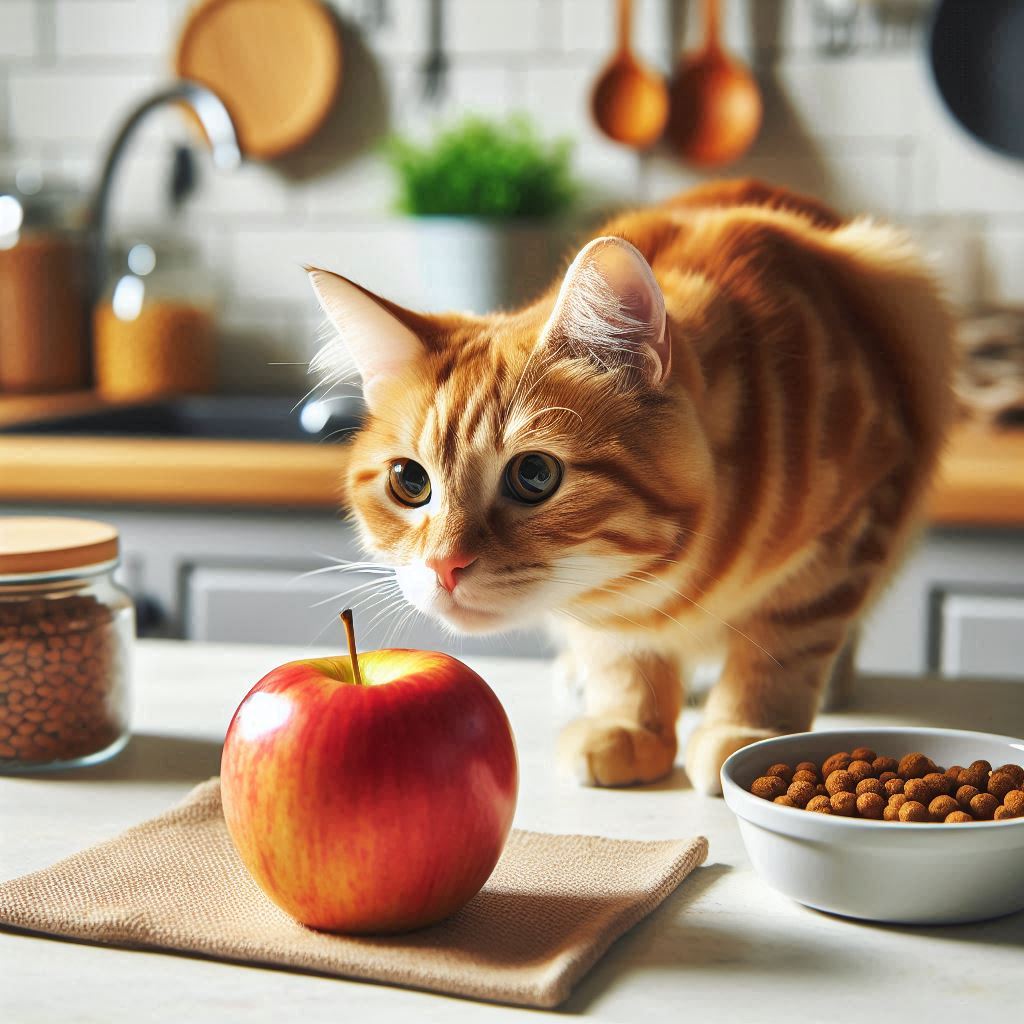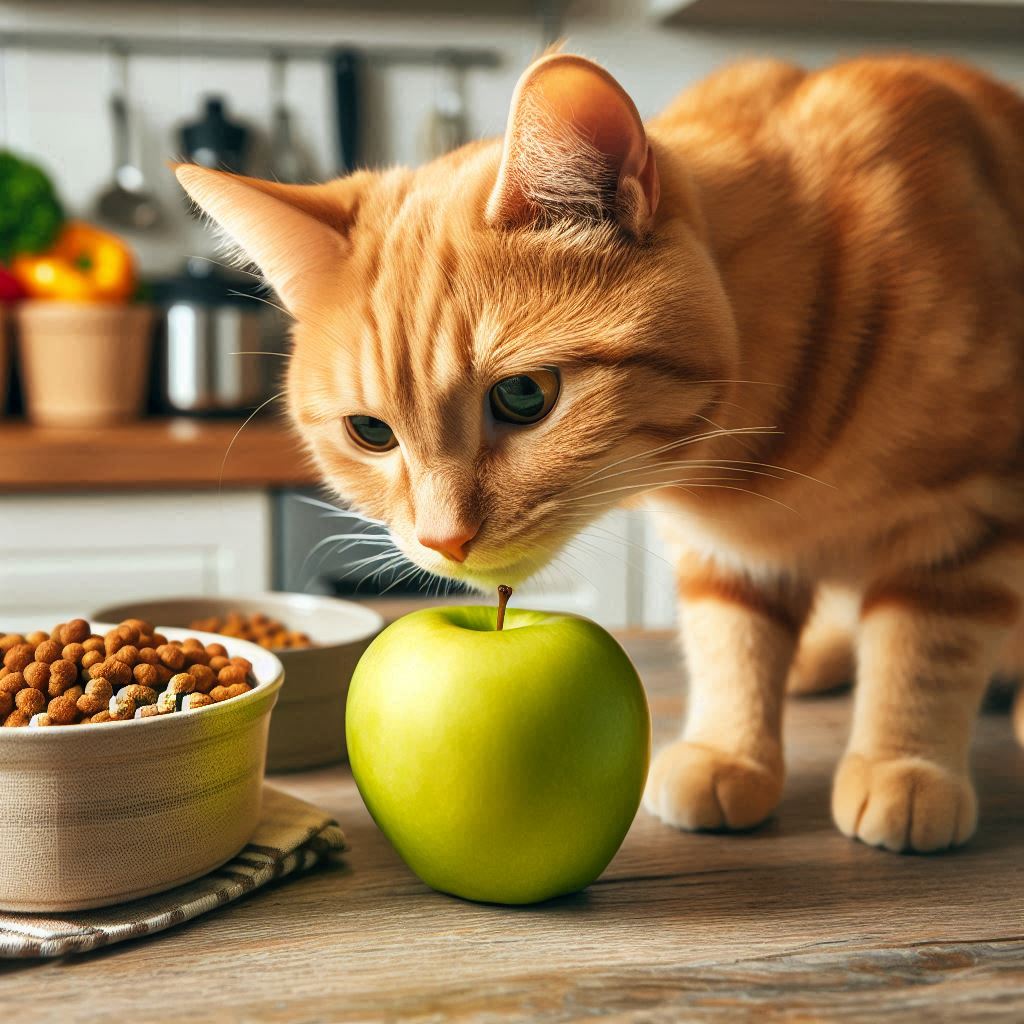
It is the rare cat owner who will catch their feline chowing down on apples. However, if you do notice your cat eating a piece of apple, should you worry? Is there a reason a cat might want or need to eat an apple?
Let’s find out together now!
Can Cats Eat Apples?
Cats can eat certain parts of the apple safely. But other parts of the apple – most particularly the seeds, stems, and leaves – can be toxic to cats.
As PetMD points out, only the peel and the inner part of the fruit is safe for cats to consume.
Learn About Cats Eating Apples
In this short, useful YouTube video, learn about whether apples are as healthy and nutritious for cats as they are for people.
Find out which parts of the apple are safe for your cat to eat and which parts need to be removed first due to toxicity concerns.
Is It Safe for Cats to Eat Apples?
According to the Feline Nutrition Foundation, cats (and all felines) are what are known as “obligate carnivores.”
This term means cat digestive tracts have evolved to digest a diet of pure animal protein – meat.
Apples, as you already know, are not meat. They are fruit.
So how can your cat possibly digest an apple?
The answer lies in developing a better understanding of what a cat’s typical prey eats, as Scientific American points out.
While cats require pure animal protein to be the majority of their diet, the majority of the prey species cats hunt eat mainly plant matter.
This means that every time a cat catches a rodent or other small animal and consumes it, the cat is also taking in the contents of that animal’s stomach, which is usually plant matter.
Of course, most prey animals don’t dine exclusively on apples. But because of the natural prey-predator cycle, your cat’s digestive tract will likely be able to handle a small amount of apple without digestive disturbance.
Do Cats Like Apples?
As the Journal of Nutrition explains, felines actually lack a certain type of receptor taste bud – the one that senses the taste we call “sweet.”
This makes sense when you consider that felines have evolved to eat a diet of pure animal protein, and animal protein is not sweet.
So it is hard to know for sure whether cats enjoy the taste of apples.
However, your cat may enjoy the texture of the skin or flesh of apples. But here again, since cats can’t tell us how they experience eating an apple, it is not possible to know for sure.
Can Apples Offer Any Nutritional Benefits to Your Cat?
Today there are many different schools of thought when it comes to feeding companion felines.
Some cat owners prefer to feed their cats a raw food diet like what a wild feline might consume.
Other cat owners choose to feed a complete and balanced commercial feline diet of dry kibble, moist or wet food, or a combination of these.
And still, other cat owners opt to make their cat’s food at home, which is called a homemade food diet.
The type of diet plan your cat is on will determine how important it is to provide additional supplements to be sure your cat is getting enough of the right nutrients at each life stage.
You should never try to balance your cat’s diet without the input of a feline veterinarian who has advanced knowledge of feline nutritional needs. There is just too much that could go wrong.
This is especially the case if you are feeding a homemade food diet, since providing the right nutrient balance in the right ways can get complicated.
But regardless of what type of daily diet your cat is eating, apples do have some important nutrients to offer your cat.

What Types of Nutrients Can Apples Offer to Your Cat?
Here is a basic list of the different nutrients that apples can provide as outlined by the Harvard T.H. Chan School of Public Health (based on one medium whole skin-on raw apple):
- 95 calories.
- 0 fat.
- 1 gram protein.
- 25 grams carbohydrates.
- 19 grams naturally occurring sugars.
- 3 grams of fiber (soluble and insoluble).
- Vitamin C.
- Phyto-nutrients: pectin, quercetin.
Pectin is perhaps the best-known nutrient that apples can provide. Pectin is actually a type of dietary fiber that is credited with helping keep elimination regular and feeds the “good” bacteria in the digestive tract.
Quercetin is less well known, but it is an equally important nutrient. Quercetin is an antioxidant flavonoid that has anti-inflammatory properties.
Of course, all of these benefits have been documented to support better nutrition for people, not for cats. So we can’t always be sure that all the nutrients in an apple will work the same way in cats that they do for people.
But there is no evidence that cats are detrimentally affected in any way by consuming small amounts of occasional whole, fresh apple flesh or peel.
Are Apples Toxic to Cats?
You may recall that we mentioned earlier in this article how certain parts of the apple can be toxic to cats.
According to the ASPCA, the seeds of the apple contain cyanide, which is a known poison.
The stems and leaves of the apple tree can also contain small amounts of cyanide.
However, as reputable pet expert Dr. Marty Becker points out, the amount of cyanide per apple seed is very minimal.
So unless your cat eats an entire bucket of apple seeds or several leafy branches, you are unlikely to see any symptoms of cyanide poisoning.
Where there is cause for worry is if your cat is still a kitten or is a very small breed of cat. Here, the bodyweight may not be sufficient to cope with even trace amounts of poison in the system before there are toxicity side effects.
What side effects should you watch for to know if your cat has ingested enough cyanide to need medical care?
The ASPCA lists the following concerning side effects.
- Bright red membranes (such as gums).
- Panting.
- Shaking.
- Respiratory difficulty.
- Pupil dilation.
- Shock.
If you see your cat exhibit any of these symptoms, take them to the nearest animal emergency clinic. And always give your veterinarian a call if you have any concerns after your cat eats any part of the apple.
How to Feed Apples to Your Cat
Your cat likely won’t seek out apples on their own, except out of sheer curiosity. But Sometimes cats want to try foods their owner is eating.
So if your cat expresses curiosity, it is fine to allow your pet to have a taste of apple.
You always want to feed raw apple, although a bit of cooked apple won’t hurt your cat. Just don’t feed your cat dried apple, which will have concentrated sugars that may be hard for your kitty to digest.
The best way to offer apples to your cat is to first remove the stem, core the apple and then remove the peel. Then you can dice up the flesh into small bits and put some in a dish for your cat to taste.
Just don’t be surprised if your kitty takes one taste and decides apples are not worth any more of their time or attention.

Hi, This is Alexa, and I love cats. This Website is a Complete Journal about how to travel with a cat and other information about Cat Health, Cat Training, Cat Behavior, Cat Foods and more. I hope you find it useful.
